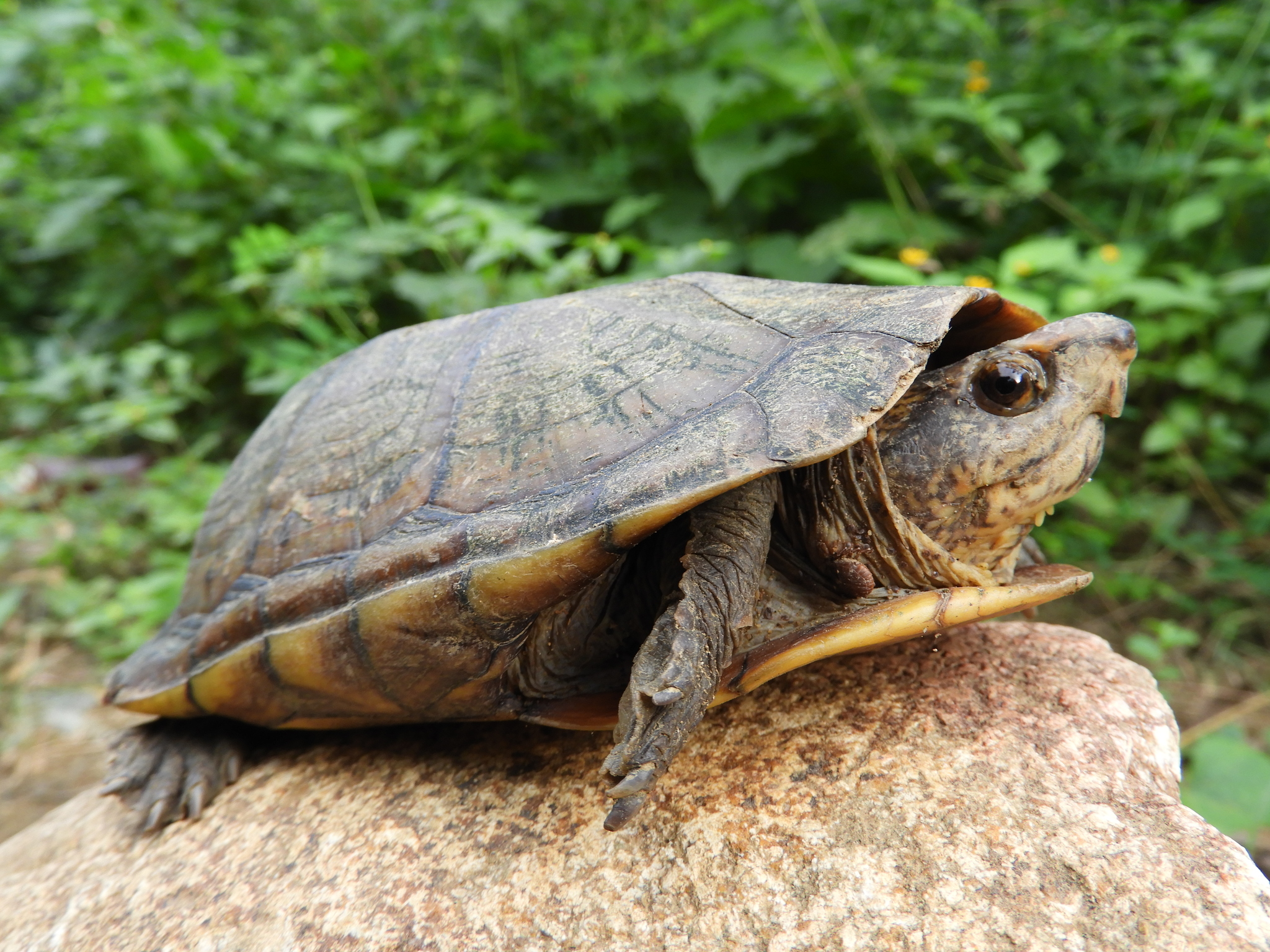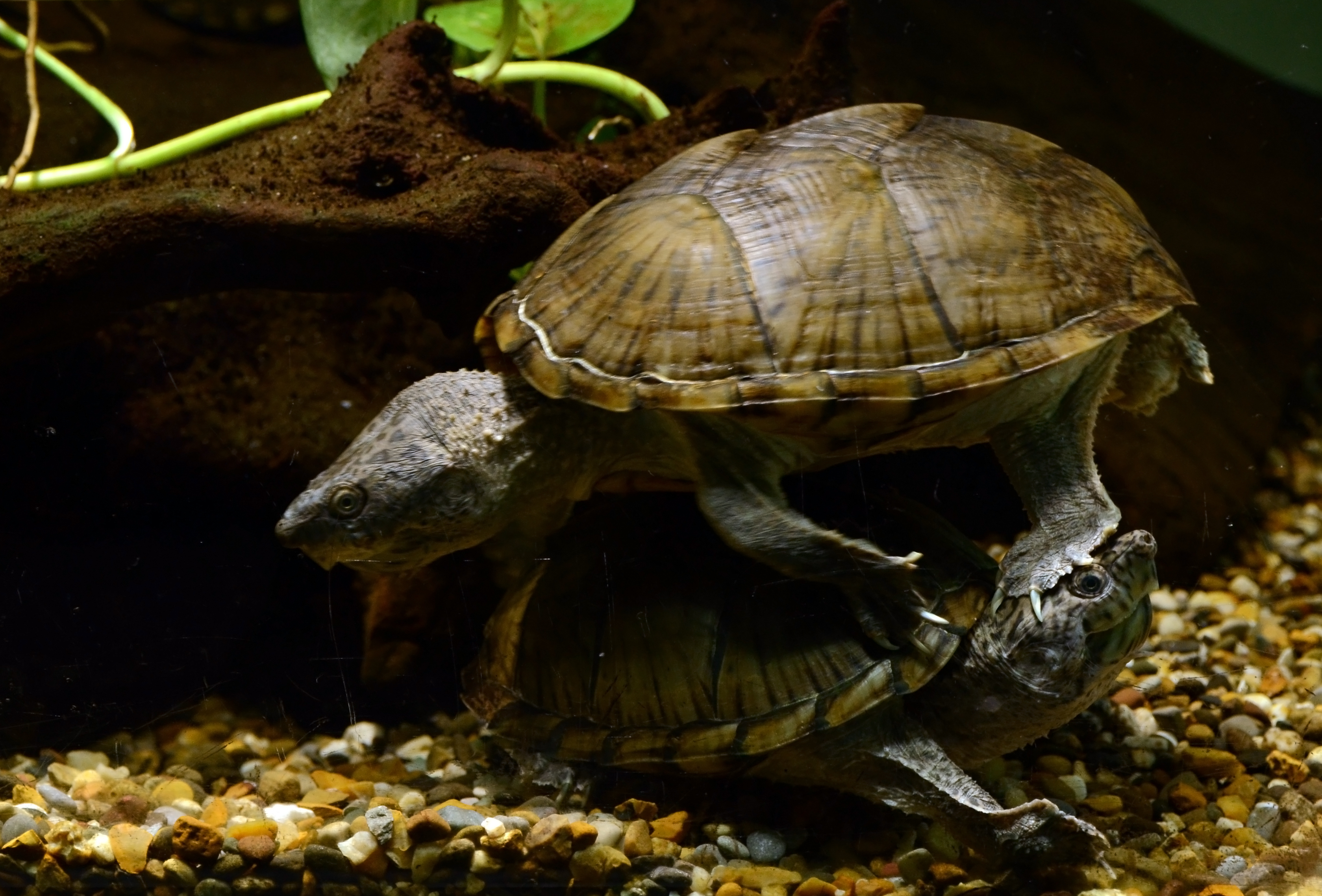|
Kinosternon
''Kinosternon'' is a genus of small aquatic turtles from the Americas known commonly as mud turtles. Geographic range They are found in the United States, Mexico, Central America, and South America. The greatest species richness is in Mexico, and only three species (''Dunn's mud turtle, K. dunni'', ''white-lipped mud turtle, K. leucostomum'', and ''scorpion mud turtle, K. scorpioides'') are found in South America. Description They are very similar to the Sternotherus, musk turtles, but generally smaller in size, and their carapaces are not as highly domed. Diet All mud turtles are carnivorous, consuming various aquatic invertebrates (especially molluscs and worms) , fish, and even carrion. Behavior Mud turtles live in the ground layer on the bed of bodies of slowly-flowing or still water. By burrowing deeply into mud, mud turtles are protected from danger. They occasionally like to bask in the sun. Species Extant *Central Chiapas mud turtle - ''K. abaxillare'' (Baur, ... [...More Info...] [...Related Items...] OR: [Wikipedia] [Google] [Baidu] |
Scorpion Mud Turtle
The scorpion mud turtle or Tabasco mud turtle (''Kinosternon scorpioides'') is a species of mud turtle in the family Kinosternidae. It is found in Mexico, Central and South America. Description The scorpion mud turtle is a medium to large kinosternid (mud turtle) with a domed, oval upper shell 92–270 mm (3.6–10.6 in) long. Males regularly exceed 200 mm. The scorpion mud turtle is a highly aquatic, adaptable kinosternid that will live in almost any body of water. Subspecies Diet It is primarily omnicarnivorous, a glutton, and feeds on a wide variety of aquatic invertebrates (such as insects and their larvae, spiders, shrimp, crabs, snails and worms) and vertebrates (such as fish and frogs), as well as carrion and bird eggshells. It also feeds on plant material such as algae, fruits, flowers, Nut (fruit), nuts, seeds and aquatic plants. In captivity, poorly fed ''K. scorpioides'' can be cannibalistic, biting off the toes and limbs of conspecifics ... [...More Info...] [...Related Items...] OR: [Wikipedia] [Google] [Baidu] |
White-lipped Mud Turtle
The white-lipped mud turtle (''Kinosternon leucostomum'') is a species of mud turtle in the family Kinosternidae. The species is endemic to Central America and northwestern South America. Etymology The synonym, ''Cinosternon spurrelli'' , which is a synonym of ''Kinosternon leucostomum postinguinale'', was named in honor of British zoologist Herbert George Flaxman Spurrell. Geographic range ''Kinosternon leucostomum'' is found in Mexico, Belize, Costa Rica, Guatemala, Honduras, Nicaragua, Panama, Colombia, Ecuador, and Peru."''Kinosternon leucostomum'' ". The Reptile Database. www.reptile-database.org. File:Kinosternon leucostomum 334068582.jpg, In Ecuador File:Kinosternon leucostomum 334068512.jpg, In Ecuador File:Kinosternon leucostomum 136814865.jpg, In Panama File:Kinosternon leucostomum 379292899 (cropped).jpg, In Costa Rica File:Kinosternon leucostomum 379292862.jpg, Plastron, in Costa Rica File:Kinosternon leucostomum 185041601.jpg, Plastron, in Belize File:Kinosternon leu ... [...More Info...] [...Related Items...] OR: [Wikipedia] [Google] [Baidu] |
Striped Mud Turtle
The striped mud turtle (''Kinosternon baurii'') is a species of turtle in the family Kinosternidae. The species is native to the southeastern United States. Etymology The specific name, ''baurii'', is in honor of herpetologist Georg Baur.Beolens, Bo; Watkins, Michael; Grayson, Michael (2011). ''The Eponym Dictionary of Reptiles''. Baltimore: Johns Hopkins University Press. xiii + 296 pp. . (''Kinosternon baurii'', p. 19). Geographic range The striped mud turtle is found in Florida, Georgia, North Carolina, South Carolina, Maryland, and Virginia. Description ''K. baurii'' has three light-colored stripes along the length of the smooth carapace. It can grow to a straight carapace length of 8–12 cm (3-4¾ inches). File:Kinosternon baurii 350774539.jpg, Carapace, Florida File:Kinosternon baurii 352995030 (cropped).jpg, Carapace, Florida File:Kinosternon baurii 342233173 (cropped).jpg, Carapace, Florida File:Kinosternon baurii 387649212 (cropped).jpg, Plastron, North Carolina ... [...More Info...] [...Related Items...] OR: [Wikipedia] [Google] [Baidu] |
Kinosternon Creaseri 28086778
''Kinosternon'' is a genus of small aquatic turtles from the Americas known commonly as mud turtles. Geographic range They are found in the United States, Mexico, Central America, and South America. The greatest species richness is in Mexico, and only three species ('' K. dunni'', '' K. leucostomum'', and '' K. scorpioides'') are found in South America. Description They are very similar to the musk turtles, but generally smaller in size, and their carapaces are not as highly domed. Diet All mud turtles are carnivorous, consuming various aquatic invertebrates (especially molluscs and worms) , fish, and even carrion. Behavior Mud turtles live in the ground layer on the bed of bodies of slowly-flowing or still water. By burrowing deeply into mud, mud turtles are protected from danger. They occasionally like to bask in the sun. Species Extant *Central Chiapas mud turtle - ''K. abaxillare'' (Baur, 1925) *Tabasco mud turtle - ''K. acutum'' Gray, 1831 *Alamos mud turtle - ... [...More Info...] [...Related Items...] OR: [Wikipedia] [Google] [Baidu] |
Tabasco Mud Turtle
The Tabasco mud turtle (''Kinosternon acutum''), commonly known as pochitoque in Tabasco, Mexico, is a small turtle which belongs to the family Kinosternidae. It can be found in central Veracruz, Tabasco, northern Guatemala and Belize. This turtle lives in small streams, marshes and ponds. Its feeding habits are mainly carnivorous and it is a nocturnal animal. Although this turtle doesn't have a wide range it can be common at some sites. In Tabasco this turtle is an important part of its popular culture as well as being an ingredient in Tabasco's gastronomy in spite of its special protected status. File:Kinosternon acutum 61641628.jpg File:Kinosternon acutum 61641648.jpg File:Kinosternon acutum 61641541.jpg Pochitoque in Tabasco's culture In this south Mexican state this turtle has a significant importance. Since ancient time Chontales have used it as an ingredient in their traditional kitchen so next to other turtle species ( jicotea and mojina), pochitoque has a huge dem ... [...More Info...] [...Related Items...] OR: [Wikipedia] [Google] [Baidu] |
Alamos Mud Turtle
The Alamos mud turtle (''Kinosternon alamosae'') is a species of mud turtle in the family Kinosternidae. It is endemic to Mexico, where it occurs in the states of Sinaloa and Sonora Sonora (), officially Estado Libre y Soberano de Sonora (), is one of the 31 states which, along with Mexico City, comprise the Administrative divisions of Mexico, Federal Entities of Mexico. The state is divided into Municipalities of Sonora, 72 .... Description The Alamos mud turtles are slightly less than average in size compared to other members of the same genus. Males tend to be larger than females, with matured females having an average carapace length of 95–100 mm, compared to an average of 90–120 mm with their male counterparts. When males are compared to females, there are a few notable differences. Males have a much narrower carapace, a shorter plastron, a shorter plastral hind lobe, narrower plastral lobes, a shorter bridge, and a shorter interanal seam.Iverson, J. B. (19 ... [...More Info...] [...Related Items...] OR: [Wikipedia] [Google] [Baidu] |
Jalisco Mud Turtle
The Jalisco mud turtle (''Kinosternon chimalhuaca'') is a species of mud turtle in the Kinosternidae family endemic to Mexico. It is found in Colima and Jalisco. They live in freshwater habitats like swamps or quiet rivers. Jalisco mud turtles reproduce oviparous, meaning the eggs hatch after the parent has laid them. Population size is unknown; there have been less than 20 individuals seen in the last twenty years. The mud turtle is said to be adapted to aquatic habitats, meaning that a population decline is then expected due to habitat fragmentation Habitat fragmentation describes the emergence of discontinuities (fragmentation) in an organism's preferred environment (habitat), causing population fragmentation and ecosystem decay. Causes of habitat fragmentation include geological proces .... References * Berry, Seidel & Iverson, 1996 : '' inosternon chimalhuaca' ''in'' Rogner, 1996 : ''Schildkröten'' (p. 23-24). López-Luna, M. A., Cupul-Magaña, F. G., Escobe ... [...More Info...] [...Related Items...] OR: [Wikipedia] [Google] [Baidu] |
Central American Mud Turtle
The Central American mud turtle (''Kinosternon angustipons''), also known as the narrow-bridged mud turtle, is a species of mud turtle in the Kinosternidae family endemic to Central America. It can be found in the following countries: Costa Rica, Nicaragua and Panama Panama, officially the Republic of Panama, is a country in Latin America at the southern end of Central America, bordering South America. It is bordered by Costa Rica to the west, Colombia to the southeast, the Caribbean Sea to the north, and .... In terms of reproduction, the female Central American mud Turtle can lay up to 4 eggs at time of reproduction, and multiple times a year. References * Tortoise & Freshwater Turtle Specialist Group 1996.Kinosternon angustipons 2006 IUCN Red List of Threatened Species. Downloaded on 5 July 2007. * Legler, 1965 : A new species of turtle, genus Kinosternon, from Central America. University of Kansas Publications of the Museum of Natural History, volume 15, number 13, pag ... [...More Info...] [...Related Items...] OR: [Wikipedia] [Google] [Baidu] |
Sternotherus
''Sternotherus'' is a genus of turtles in the family Kinosternidae including six species commonly known as musk turtles. The genus is endemic to North America, occurring in the eastern third of the US and southeast Ontario, Canada. Musk glands positioned near the bridge of the shell can produce foul smelling secretions when the turtles are threatened, although gentle handling does not normally provoke a response. ''Sternotherus'' are moderately small turtles, with the largest species in the genus, the razor-backed musk turtle ('' S. carinatus''), attaining a maximum of 17.6 cm. in shell length. The carapace is characteristically oval and domed (an exception being the flattened musk turtle, '' S. depressus''), with most species having one or three keels on the back which may become smoother and obscure with age in some species. Musk turtles are generally drab in color, mostly black, gray, brown, olive, or ocher, which aid in camouflaging them in their natural habitats. The hea ... [...More Info...] [...Related Items...] OR: [Wikipedia] [Google] [Baidu] |
Dunn's Mud Turtle
Dunn's mud turtle (''Kinosternon dunni''), also known commonly as the Colombian mud turtle, is a species of turtle in the family Kinosternidae. Etymology The epithet or specific name, ''dunni'', honors Emmett Reid Dunn, an American herpetologist. Geographic range ''K. dunni'' is endemic to Colombia. Habitat The preferred natural habitat In ecology, habitat refers to the array of resources, biotic factors that are present in an area, such as to support the survival and reproduction of a particular species. A species' habitat can be seen as the physical manifestation of its ... of ''K. dunni'' is freshwater swamps and slow rivers. www.reptile-database.org. References External links *Tortoise & Freshwater Turtle Specialist Group (1996).''Kinosternon dunni'' 2006 IUCN Red List of Threatened Species. Downloaded on 29 July 2007. Bibliography * * Schmidt KP (1947). "A New Kinosternid Turtle from Colombia". ''Fieldiana Zoology'' 31 (13): 109–112. (''Kinosternon dunni ... [...More Info...] [...Related Items...] OR: [Wikipedia] [Google] [Baidu] |




